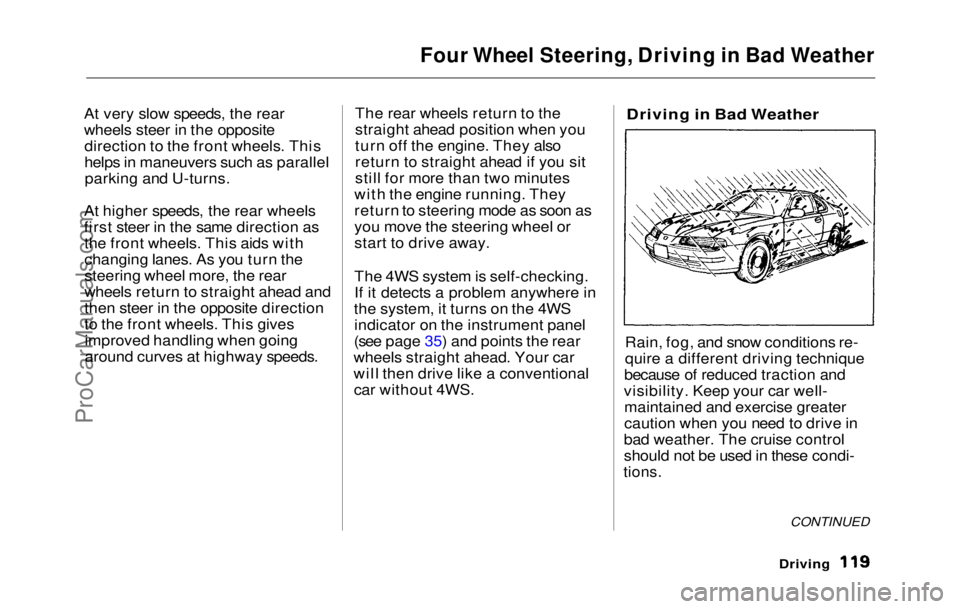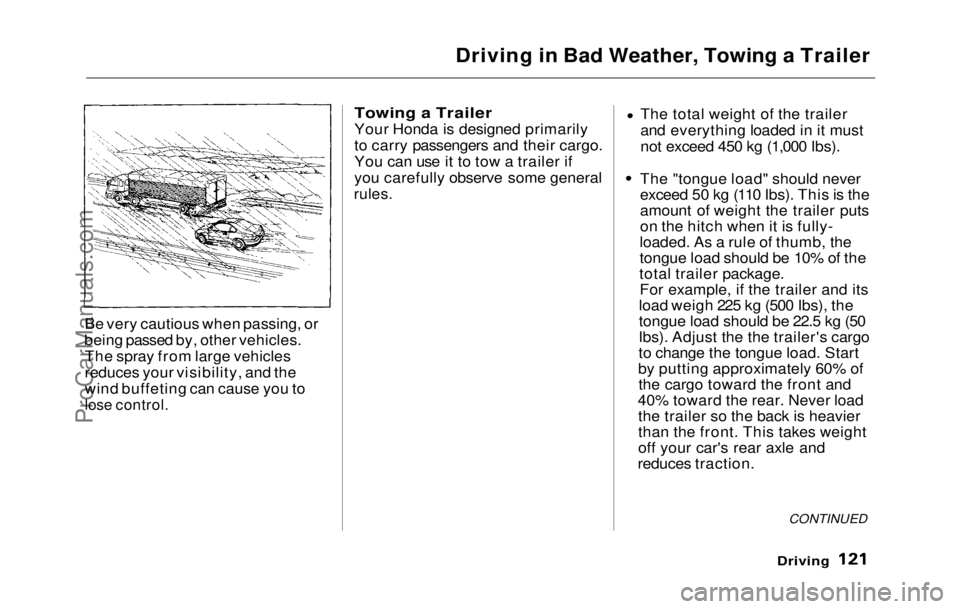traction control HONDA PRELUDE 1992 Owners Manual
[x] Cancel search | Manufacturer: HONDA, Model Year: 1992, Model line: PRELUDE, Model: HONDA PRELUDE 1992Pages: 225, PDF Size: 2.1 MB
Page 116 of 225

The Braking System
If this happens, you will immediate-
ly notice that the brake pedal goes
down much farther and you need to press on it much harder. A much
longer distance will be needed to stop the car.
Slow the car by downshifting to a
lower gear and removing your foot
from the accelerator pedal. Pull to
the side of the road as soon as it is
safe. Because of the longer stop-
ping distance needed, brake system
failure is very hazardous. It is best
to have your car towed, but if you
must drive the car in this condition,
be extremely cautious. Have your car repaired as soon as possible.
Anti-lock Brakes
The Prelude Si and Si 4WS models
in
the U.S. and SR and SR 4WS
models in Canada have an Anti-
lock Brake System (ABS) as standard equipment.
ABS helps you maintain steering
control. It does this by helping you
to prevent the wheels from locking
up and skidding.
The ABS is always "On". It
requires no special effort or driving
technique. You will feel a pulsation
in the brake pedal when the ABS
activates.
Activation varies with the amount of traction your tires have. On drypavement, you will need to press on
the brake pedal very hard before
you feel the pedal
pulsation that
means the ABS has activated.
However, you may feel the ABS
activate immediately if you are
trying to stop on snow or ice. Under all conditions, the ABS is helping to
prevent the wheels from locking so
you can retain steering
control.
You should continue to press on the
brake pedal with the same force.
You may feel a slight movement of
the brake pedal just after you start
the engine. This
is
the ABS
working.
Driving
CONTINUEDProCarManuals.comMain Menu Table of Contents s t
Page 118 of 225

Four Wheel Steering, Driving in Bad Weather
At very slow speeds, the rear
wheels steer in the opposite direction to the front wheels. This
helps in maneuvers such as parallelparking and U-turns.
At higher speeds, the rear wheels
first steer in the same direction as the front wheels. This aids with
changing lanes. As you turn the
steering wheel more, the rear
wheels return to straight ahead and
then steer in the opposite direction
to the front wheels. This givesimproved handling when going
around curves at highway speeds. The rear wheels return to the
straight ahead position when you
turn off the engine. They also
return to straight ahead if you sit
still for more than two minutes
with the engine running. They
return to steering mode as soon as
you move the steering wheel or
start to drive away.
The 4WS system is self-checking.
If it detects a problem anywhere in
the system, it turns on the 4WS indicator on the instrument panel
(see page 35) and points the rear
wheels straight ahead. Your car
will then drive like a conventional car without 4WS.
Driving in Bad Weather
Rain, fog, and snow conditions re-
quire a different driving technique
because of reduced traction and
visibility. Keep your car well- maintained and exercise greater
caution when you need to drive in
bad weather. The cruise control
should not be used in these condi-
tions.
CONTINUED
DrivingProCarManuals.comMain Menu Table of Contents s t
Page 119 of 225

Driving in Bad Weather
Driving Technique — Always
drive slower than you would in dry
weather. It takes your car longer to react, even in conditions that may
seem just barely damp. Apply
smooth, even pressure to all the
controls. Abrupt steering wheel
movements or sudden, hard appli-
cation of the brakes can cause loss
of control in wet weather. Be extra
cautious for the first few miles of
driving while you adjust to the change in driving conditions. This
is especially true in snow. A person
can forget some snow-driving tech- niques during the summer months.
Practice is needed to relearn those
skills.
Exercise extra caution when
driving in rain after a long dry spell.
After months of dry weather, the
first rains bring oil to the surface of
the roadway, making it slippery. Visibility — Being able to see
clearly in all directions and being
visible to other drivers are impor-
tant in all weather conditions. This is more difficult in bad weather. To
be seen more clearly during day-
light hours, turn on your headlights.
Inspect your windshield wipers and
washers frequently. Keep the wind- shield washer reservoir full of the
proper fluid. Replace the wind-
shield wiper blades if they start to
streak the windshield or leave parts
unwiped. Use the defrosters and air conditioner to keep the windows
from fogging up on the inside (see
page 73).
Traction — Check your tires
frequently for wear and proper pressure. Both are important in
preventing "hydroplaning" (loss of
traction on a wet surface). In the
winter, mount snow tires on all four
wheels for the best handling.
Watch road conditions carefully, they can change from moment to
moment. Wet leaves can be as slip-
pery as ice. "Clear" roads can have
patches of ice. Driving conditions
can be very hazardous when the
outside temperature is near freez-
ing. The road surface can become
covered with areas of water pud-
dles mixed with areas of ice, so
your traction can change without
warning.
Be careful when downshifting. If
traction is low, you can lock up the
drive wheels for a moment and
cause a skid.
DrivingProCarManuals.comMain Menu Table of Contents s t
Page 120 of 225

Driving in Bad Weather, Towing a Trailer
Be very cautious when passing, or
being passed by, other vehicles. The spray from large vehicles
reduces your visibility, and the
wind buffeting can cause you to
lose control.
Towing a Trailer
Your Honda is designed primarily
to carry passengers and their cargo.
You can use it to tow a trailer if
you carefully observe some general
rules.
The total weight of the trailer
and everything loaded in it must
not exceed 450 kg (1,000 Ibs). The "tongue load" should never
exceed 50 kg (110 Ibs). This is the
amount of weight the trailer puts
on the hitch when it is fully-
loaded. As a rule of thumb, the
tongue load should be 10% of the
total trailer package. For example, if the trailer and its
load weigh 225 kg (500 Ibs), the
tongue load should be 22.5 kg (50
Ibs). Adjust the the trailer's cargo
to change the tongue load. Start
by putting approximately 60% of the cargo toward the front and
40% toward the rear. Never load the trailer so the back is heavier
than the front. This takes weight
off your car's rear axle and
reduces traction.
CONTINUED
DrivingProCarManuals.comMain Menu Table of Contents s t
Page 160 of 225

Tires
Traction
The traction grades, from highest
to lowest, are A, B, and C, and they
represent the tire's ability to stop
on wet pavement as measured
under controlled conditions on
specified government test surfaces
of asphalt and concrete. A tire
marked C may have poor traction
performance.
Warning: The traction grade as-
signed to this tire is based on brak-
ing (straight ahead) traction tests
and does not include cornering
(turning) traction.
Temperature
The temperature grades are A (the
highest), B, and C, representing the
tire's resistance to the generation
of heat and its ability to dissipate
heat when tested under controlled
conditions on a specified indoor
laboratory test wheel. Sustained
high temperature can cause the
material of the tire to degenerate
and reduce tire life, and excessive
temperature can lead to sudden tire
failure. The grade C corresponds to a level of performance which all
passenger car tires must meet
under the Federal Motor Vehicle
Safety Standard No. 109. Grades B
and A represent higher levels of
performance on the laboratory test
wheel than the minimum required
by law. Warning: The temperature grade
for this tire is established for a tire
that is properly inflated and not
overloaded. Excessive speed,
underinflation, or excessive loading.
either separately or in combination,
can cause heat build-up and
possible tire failure.
MaintenanceProCarManuals.comMain Menu Table of Contents s t